In early 2021, Teledyne acquired FLIR to complement its wide array of products that covered the electromagnetic spectrum but not its infrared portion, becoming Teledyne FLIR. Together, both companies are developing new products to address all the measurement, imaging, and data gathering across the whole electromagnetic spectrum, whether under the sea, on the land, in the air, or even in space.
Later that year, the company hosted the "4 Reasons Why UAS Drone Pilots Need Clear Radiometric Thermal Zoom" webinar. Presented by Kelly Brodbeck, Product Manager for Teledyne FLIR's Commercial UAS Division, the webinar introduced a new sensor, the TZ20-R, and aimed to explain how the combination of superior optical thermal zoom and radiometry enables more efficient search and surveillance, safer inspection, and better reporting for drone pilots.
Today, at one level or another, we're all photographers. Be it with a professional or a smartphone camera, we understand the concept of zooming in and out while taking a picture and how important that feature is in certain situations. Getting closer to your subject is always a good thing as it allows more flexibility with your compositions. Zoom becomes an essential feature for a drone where you often cannot get very close to your subject due to terrain difficulties or regulations.
Also, most people understand the value that thermal cameras on drones can provide since they've been out there for quite a while now. For example, during a fire like the one in the image below, smoke can obscure the hottest parts, making it harder for First Responders to act. With a thermal camera mounted on a drone, First Responders have more information and can take action quicker, resulting in a more efficient and safer job.
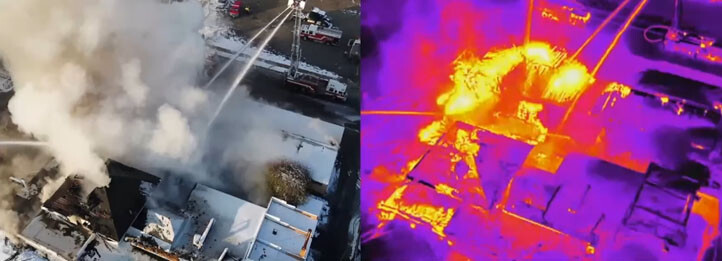
Another essential feature is radiometry, which is the process of taking the information that's at every pixel in a thermal image and associating it with something that the human brain can understand - like a temperature.
"There are lots of things you can do with radiometry," Brodbeck said during the webinar. "In the picture below of a substation, you can see several white areas that I don't have highlighted red. They're glowing and warm, but are they areas of concern? Hard to say. You're not getting the full story if you don't have radiometry in a thermal picture. By enabling radiometry, I've turned on what we call an isotherm to shade anything in the color red that's above a certain threshold. In this case, 75 degrees Celsius and above because anything below isn't much of a concern. With radiometry, you get a lot more information out of a thermal picture."
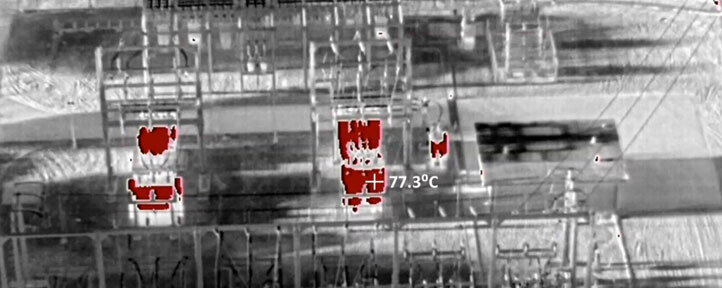
While there are plenty of radiometric cameras out there that do a thermal zoom, the more zoomed up a picture gets, the fuzzier it is, to the point where it's no longer useful. "I speak with a lot of people at trade shows and other events, and when I talk about thermal zoom, people aren't super excited about it because you get this blurriness," Brodbeck explained. "Not only are these not great pictures, but they could also actually be misleading."
With that in mind, Teledyne FLIR launched the TZ20-R last year to improve all these features over their competitors. The TZ stands for thermal zoom, 20 for 20x zoom level, and R for Radiometry, which correspond to three of the four pillars the company wanted to enable with the new product – Clear Radiometric Imagery, See More in Less Time, Safe Stand-Off, And Effective Reporting. As part of DJI's ecosystem, the TZ20-R is compatible with the Matrice V2 200 and 300-series.
What's key and unique about the TZ20-R that, according to Brodbeck at the time, no one else had, is it has two boson thermal cameras in it - one set to a narrow field of view and the other set to a wide field of view. With the dual boson cameras configured with different fields of view, a simple switch between them allows users to maximize situational awareness since, with a simple zoom-out, you can quickly figure out where you are.
"Other cameras will start at their base level, or their 1x level, rather zoomed up," stated Brodbeck. "They do that so that when they go to 4x, 8x, and other zoom levels, they have some sort of meaningful picture. If they started pulled back as far as we do, they wouldn't have a very good picture by the time they zoomed up. With us, you have this very wide field of view at the base level, but then you can switch between all these different zoom levels with just the push of a button on the DJI controller."
Most of the leading cameras out there have a 640x512 resolution thermal camera, where at the 1x zoom level everybody's at 327000 pixels on target. However, what everybody else does is to digitally zoom right from the start, taking a piece of the original picture, blowing it up, and losing pixels at the same time. At 5x, the competitor would be down to 23% of what they started with, whereas the TZ20-R doesn't lose any pixels on target, providing a clear image at a very high altitude because it is just a switch from one camera to another.
"It's kind of a pseudo optical zoom, and we maintain the 327000 pixels on target," Brodbeck added." From there, we do digitally zoom to get the 10x and 20x, but at every zoom level, we're going to have four times more pixels on target, hence why the images from this product are so much clearer than what you get from everybody else."
For example, take the picture below of a transmission tower taken about a hundred feet away. With the competitor at maximum zoom, you can't tell if the vibration dampener is correctly installed, touching the line, or exactly what it is. But with the TZ20-R, the gap between the line and the vibration dampener is clear. "This is what dual boson technology is all about," Brodbeck stated.
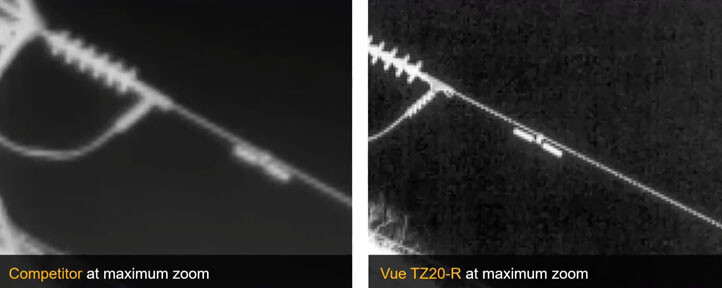
And here's two images that were taken about a third of a mile away, 200 feet in the air, from a hotel courtyard during a simulated surveillance situation. On the left, the competitor at maximum zoom doesn't provide enough details to understand a whole lot, and it's already maxed out. With the TZ20-R on the right, you can clearly see what's going on.
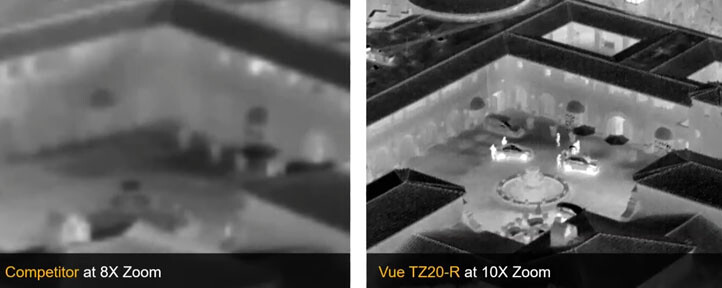
During the webinar, Brodbeck shared a few more examples of how the TZ20-R makes a difference. In a simulated search and rescue situation, about 150 feet in the air and a couple of hundred yards away from the subject, at 10x zoom, the TZ20-R allowed law enforcement officers to point out that the person was holding a gun. With a competitor sensor at 8x zoom, it was all blurry, almost even impossible to know if it was a person or not they were seeing.
Coming back to radiometry, the TZ20-R also includes a spot meter to measure temperatures and easily find hotspots. Brodbeck showcases this with a video taken 150 feet away from transmission lines using 5x and 10x zoom levels to maintain a safe standoff while easily measuring insulators' temperatures on the transmission lines' tower.
Another radiometry feature that the TZ20-R has is the Region of Interest, shown in the image below. It consists of a box with a red and blue triangle that point to the hottest and the coolest pixels in that area, respectively. It also provides three temperature measurements – two from the red and blue triangles and the average temperature from that area.
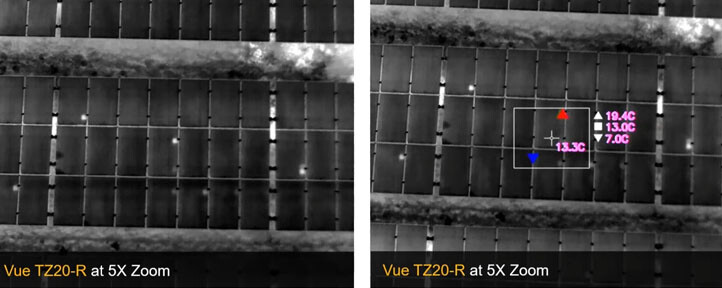
Finally, the fourth pillar of Teledyne FLIR's program is to simplify reporting. The company's FLIR Tools are currently in an end-of-life process since the users' feedback was that "it is better than other solutions, but it's too oriented toward handheld thermography and not drones." So, the company came up with FLIR Thermal Studio, designed to take very large amounts of images and do batch processing on them. For example, a user can pull forward pictures with temperatures above a certain threshold, and the software quickly creates professional reports automatically with your criteria. There's a free version that you can download and see what it does.
"It's all about making your life easier and telling the story that you want by grouping and analyzing large amounts of data in just a few minutes," Brodbeck said. "One of the new features allows you to combine a physical map with the image and video you have taken. This is ideal for infrastructure inspections, like roads, bridges, etc., as it puts your imagery into the context of physical locations so you know where you're at. "
If you compare the price of the TZ20-R plus a visible camera like DJI Z30 to the $12000 DJI H20T, which is an all-in-one visible and thermal camera, the TZ20-R + Z30 is significantly cheaper. Brodbeck says this comes at "a better value and provides better pictures."
Click here to watch the whole webinar.


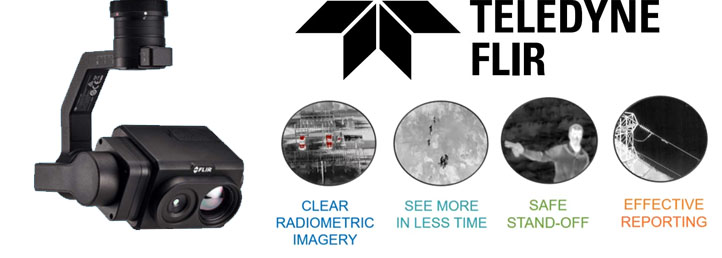













Comments